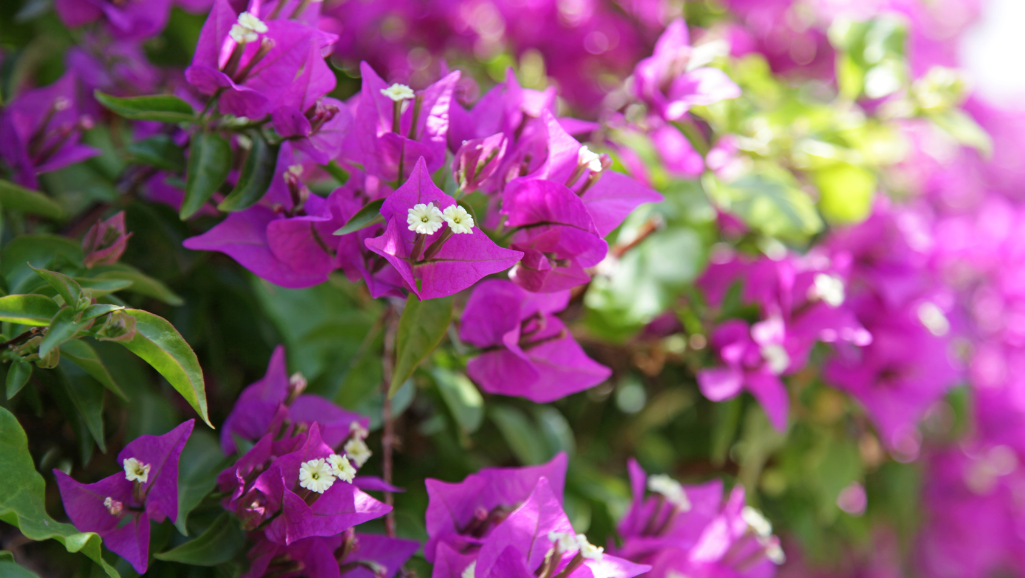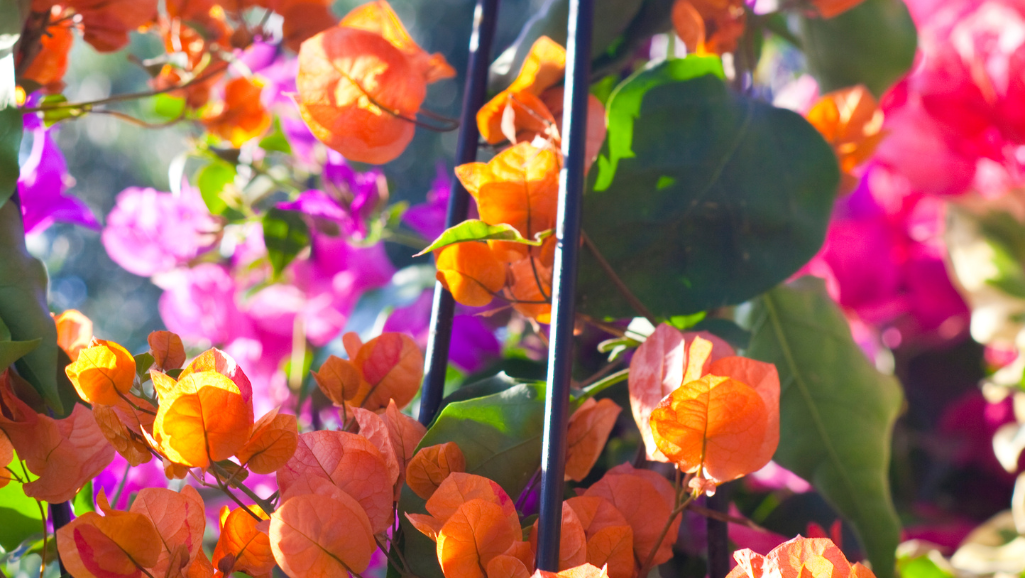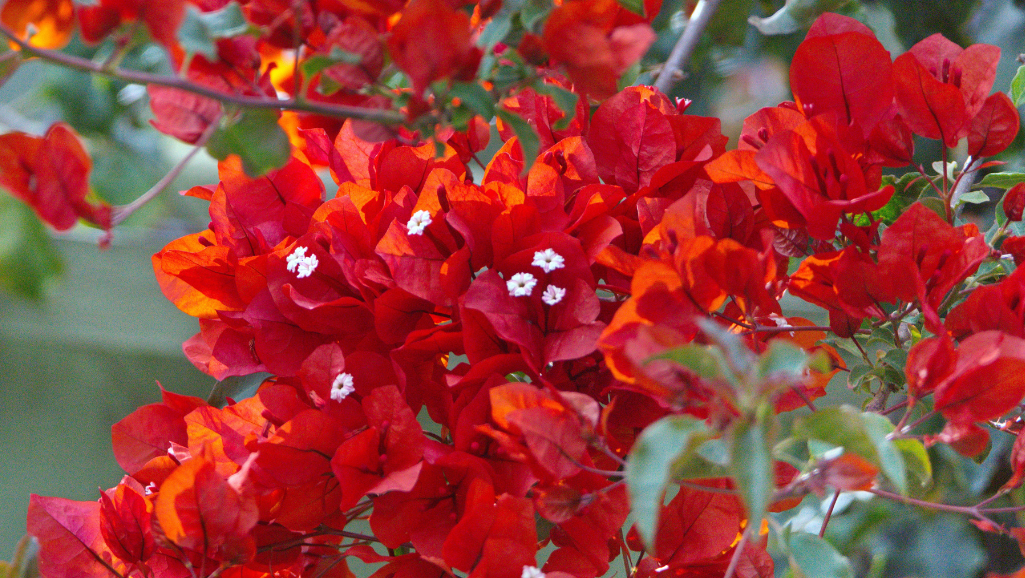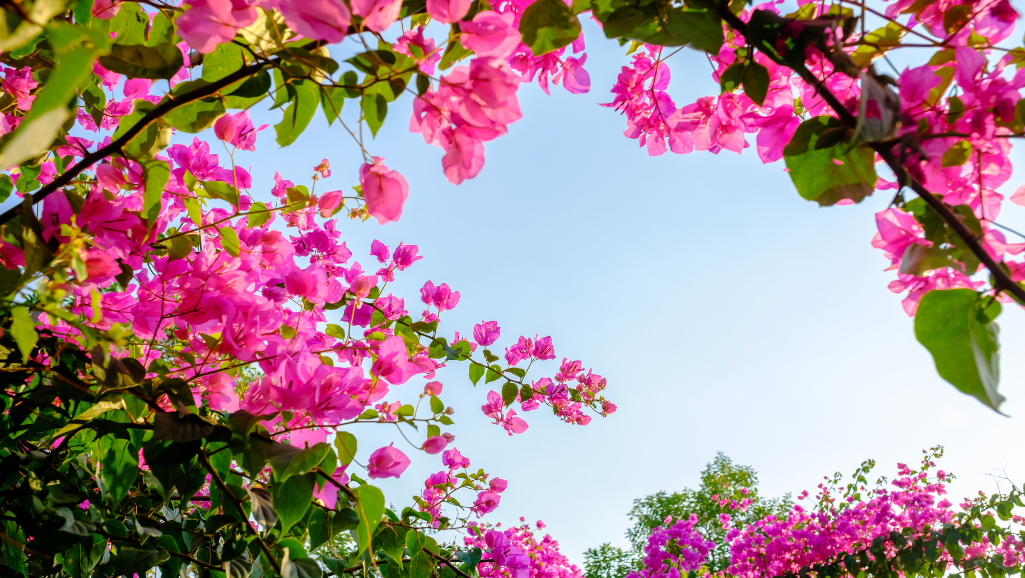We know that spring has sprung (so early this year) when all the colorful annuals and perennials start arriving wave upon wave at Rainbow Gardens. But when bougainvillea show up and start strutting their stuff, it’s like they are the peacocks amongst a bunch of pigeons. Don’t get me wrong, there is color all over the nursery right now, and more color to come. But when you see a grouping of bougainvillea, or walk underneath a row of them in hanging baskets, they are truly stunning and you definitely get dazzled by the brilliance of their colors. Let’s celebrate bougainvillea today!


Bougainvillea: Color and Fertilizer
Interestingly enough, the bold color that attracts us to bougainvillea is not coming from the flowers of the plant at all. The colorful papery structures on bougainvillea are called bracts. The actual flowers are small and white, and are surrounded by the bracts which are responsible for the plant’s vibrant color display. Look for gorgeous hues of magenta, cotton candy pink, yellow, deep orange, white, bicolor, red, and hot pink.
To keep that color blazing for a long time, offer a monthly dose of fertilizer during the months of February through September. Stop fertilizing in October so you don’t risk pushing new growth that could get damaged in winter weather. Choose a balanced fertilizer with equal amounts of nitrogen, phosphorus, and potassium (20-20-20).


Bougainvillea: Planting Requirements
Bougainvillea can be sensitive to cold temperatures, so it’s best to plant them after the last frost. While they can tolerate temperatures as low as 30-35°F (-1 to 2°C) for a short period of time, long exposure to freezing temperatures can damage or kill the plant. In general, under 32°F is putting them in the danger zone.
When planting bougainvillea in San Antonio, Texas, it’s important to choose a location with full sun exposure, well-draining soil, and protection from harsh winds.
- Full sun means at least 6-8 hours of sunshine; less than that and you will have a beautiful green plant, but little if any phosphorescent color.
- Bougainvillea do best when watered deeply and regularly, but be careful not to over-water as this can lead to root rot, hence the need for well-draining soil along with holes in the bottoms of pots if planting in containers.
- Winds can cause stress on tender new shoots, that while flexible can still bend and break. Leaves and bracts may fall leaving your bougainvillea looking rather ‘naked’.


Bougainvillea: Potting and Pruning
If planting bougainvillea in containers, don’t be so quick to repot them. They actually prefer to be somewhat rootbound. Check their root system in their nursery pot. If roots still have a way to go before encircling the base, you might want to leave them in there and drop the nursery pot into a decorative pot. It’s still generally recommended to repot them every 2-3 years to ensure proper growth and health. Just be ready for a period of adjusting to it’s new environment once repotted (temporary wilt, leaf drop).
All pruning (especially hard pruning) should be done late winter/early February. Sometimes they need to be cut back to the ground (if we’ve had a severe winter freeze). If we haven’t had a killing freeze, bougainvillea will still benefit from pruning lanky shoots by about 1/3, and removing limbs that are crossing over and rubbing against each other. BEWARE the thick, long thorns! They are no joke. Wear thick gloves and shoes with thick soles. Trust me on this one. It’s easy to step on a discarded limb. I’ve had thorn go up the sole of my tennis shoes before, ouch!
Interested in bougainvillea now? Well come get ’em! We have some beautiful selections at Rainbow Gardens right now, and more to come.
~The Happy Gardener, Lisa Mulroy


Price on bougainvillea?
Hi Sabrina,
Range of price on bougainvillea runs:
4″ 6.99
1 gallon $14.99-16.99
Hanging baskets 31.99
3 gallon 36.99
prices may vary at each location.
I had 2 planted fairly close together in my garden, and they were just beautiful. They grew about 12 feet high with arching branches, but I got tired of looking, like I had been in a catfight, every spring after pruning them, and I took them out. I really regret that decision!
Oh no! Sorry Gail. Maybe it’s time to try some again! Long sleeve shirts and long sleeve gloves are definitely recommended. Those thorns are no joke!
Use a pole chain saw!!!
Good advice!!
Thank you for this very informative article. Love hanging baskets of bougainvillea adding beautiful color to our backyard.
HI Betty!
So happy to hear you are enjoying your bougainvillea! Bet they look gorgeous in your backyard!
I had 5 Different color Bogey’s And lost all but one In our horrible winter / snow. I was so devastated Because they are so beautiful. Purchased 2 at rainbow garden this year in the Spring, A golden and a vibrant red. They are gorgeous. I also have a very purple and a Burnt orange one. This year they will all be cut back at the same time and hopefully Shoot their color at the same time In the Spring .The ones I lost before were always bloomed at the same time.
Do you guys offer bulk discounts? I am looking for 250 bougainvillea plants, ideally 3 gallon, with a stake, so that they can be trained to climb a fence.
Hi Seth,
I have forwarded your request to one of our managers to see what is possible. It will depend on growers supply.
Hello Happy Gardener,I live in Austin TX, Central Texas,I’ve planted Bougainvilleas before with no success, probably because of partly sun,as I planted them in My backyard away from the morning Eastern Sunrise, after reading info on Your page,I will give it another shot this coming Spring,I’m planting My next ones in My front yard,but come Winter,I will be a little worried,as We’ve had Harsh February’s 2 out of the last 3 Winters,any Suggestions? Frank
Hi Frank,
Yes, the winter’s have been somewhat unpredictable lately for sure. The joy of living in Texas! I’d be looking to plant them in the warmest section of your landscape, we have micro climates throughout, and a few degrees can make all the difference. Plant in an area that gets as much sun as possible. Then follow our advice for winter protection in the event of a forecasted freeze right here. Incandescent lights and freeze protection from the top draping all the way to the bottom where it can be secured can mimic a little greenhouse effect through the winter, but if we have another raging storm, there is not much you can do about it. Unless you keep them potted to where you can bring them in.
My bougainvilleas are not doing well in the 3 years we’ve had them. Location Bay of Banderas Nayarit Mexico. How often should they be watered? They are in our courtyard which receives plenty of sun. They are watered once a week. The one left in the plastic pot is doing better than the one we transplanted directly into the clay pot.
Hi Christina,
When you say they are not doing well, what symptoms are you seeing? It sounds like your watering schedule is right, and that they are receiving enough sun. Do the pots you have them in have plenty of drainage holes? It’s possible it might be time to repot them, but since bougainvillea like to be somewhat rootbound, I would caution going up too large of a container. Maybe just the next size. Have you offered them any fertilizer?
Can you recommend Bougain fertilizer for Bouganvillias? You mentioned a 20-20-20 fertilizer. Bougains fertilizer is 6-8-10.
Thank you
Hi there.
Yes we carry some fertilizers that are labeled specific to bougainvillea. The 20-20-20 is actually a fertilizer that has been recommended by TAMU Agrilife Extension Service for years, and is also widely recommended by other Texas nurseries for bougainvillea as well . We carry Nelson Plant Food Nutristar Bougainvillea 17-7-10 fertilizer that is specifically labeled for bougainvillea if you would like to go that route. These are great options to get your bougainvillea vine jump started, especially after winter. If you need to push some blooms out, I’d recommend alternating your feedings with a 20-20-20 and another fertilizer with a higher phosphorous number (number in the middle). We carry FoxFarm Fruit and Flower granular fertilizer (4-9-3) and Maestro Gro Rose Glo (6-8-4); either of these are great for blooms. you could also supplement with a higher phosphate liquid fertilizer such as FoxFarm Big Bloom or Tiger Bloom. Hope this helps.